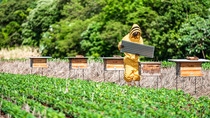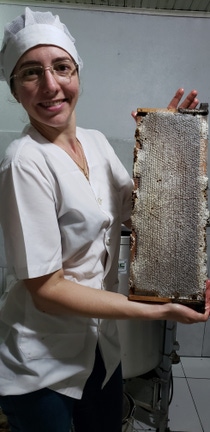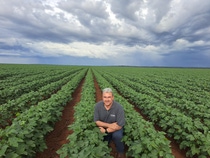Average of13%
higher productivity
when soy is pollinated by honey bees
(according to Embarapa research)
Enhance Biodiversity
Helping farmers to do the Biggest job on earth

Agriculture
Unlike most farming practices that are solidified into tradition through season after season hard work and continuous improvement, parking beehives on soybean fields isn’t a common practice – on the contrary, many beekeepers tend to avoid the proximity to soybean fields, fearing that crop protection treatments could potentially impact their bees. Coexistence has been a challenge even with research piling up showing the benefits to both soybean yield and honey production. The need to protect crops from pests and the potential impact of insecticide applications on pollinators create complexities that require close cooperation and communication to realize these benefits.
What initially appeared to be an unbridgeable gap between Brazilian soybean farmers and beekeepers was taken as an opportunity to promote the integration of pollination services in soybean production – by proving the benefits for both sides.
Average of13%
higher productivity
when soy is pollinated by honey bees
(according to Embarapa research)
BASF and Embrapa developed a project to enable beekeepers and soybean farmers in how to work together. The project was based on previous studies that identified the potential for harmonious coexistence if certain rules were followed by both parties.
The participating farmers and beekeepers agreed to a comprehensive set of good practices, encompassing agricultural, beekeeping, and communication aspects – among them farmer Ivo Muller and beekeeper Aldo Machado dos Santos.
“The question is how to apply herbicides or insecticides to avoid any harm to the hives.”
Ivo Muller, Farmer
Ivo was born into a farming family and often pondered the question of “how to apply herbicides or insecticides to avoid any harm to the hives.” Aldo worked as a tobacco grower before he decided to take up beekeeping in search of greater security and the preservation of biodiversity.
“We only work with conscientious producers whom we know will strictly follow the recommendations of the products.”
Aldo Machado dos Santos
Beekeeper
Hover your mouse over the images to see what’s behind them.
Aldo summarizes quite clearly the advantages of a harmonious coexistence, “It’s good for the beekeeper who is not just feeding but also earning from the bees. It’s good for the soybean producer, who benefits from increased production due to pollination and it’s good for the bees, as they are working in their natural environment.”
Ligia Mara Jung, a farmer and beekeeper, is one of the experts who validated the study results in the fields, and she is thrilled about the outcome. For her, beekeeping in soybean fields was a tradition that evolved naturally on her family’s farm in Floresta, a city neighboring Maringá in the Paraná state of Brazil.
“There were always two or three beehives that we kept and used for sugar,” she says of what was their coffee farm in the 1950s. “My father found swarms of the honeybees in the field after we transitioned to soybean, so he set up boxes for them, so they could stay close to the crops.” Over time, her father continued to expand, capturing swarms and making more boxes for bees. Their honey harvests grew, and they also noticed how the presence of the bees improved soybean production.
“We never had any problems on our property and always thought that the two activities go well together.”
Liga Mara Jung
Beekeeper and Soy Farmer
“We never had any problems on our property and always thought that the two activities go well together. But most farmers and beekeepers are more hesitant. The farmers think it’s simply more work to adopt practices that are favorable to bees and the beekeepers are afraid of bee mortality if they put their apiaries too close to soybean fields,” she says. “The Embrapa project proved us right and has been a major step to change this. Hopefully the word will spread, and more soybean farmers and beekeepers will benefit from these insights.”
“At the end of the season, the feedback from all participants was great. We will definitely continue and extend this initiative”, reflects Maurício do Carmo Fernandes, BASF Stewardship and Sustainability Manager for Agriculture Solutions in Brazil. To encourage the adoption of these successful practices between beekeepers and farmers in the region, an information booklet and a distance-learning course based on the study results are planned. “It creates a win-win situation”, concludes Maurício, where biodiversity and productivity go together with the benefit for both.
“It creates a win-win situation – and benefits the planet.”
Maurício do Carmo Fernandes
BASF Stewardship and Sustainability Manager for Agriculture Solutions in Brazil
So, the next time you enjoy your breakfast, remember the incredible journey that brought these ingredients to your table. It’s a story of collaboration, innovation, and a shared commitment to harmonious coexistence between nature and agriculture.
Published October, 2024 by Katie Lelito and Panagiota Boumpalou (BASF Global Agricultural Solutions).
For media inquiries or to repurpose the story, please contact:
verena.kempter@basf.com
Sources:







